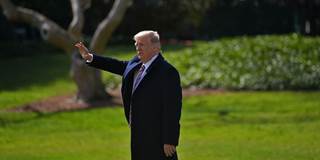Donald Trump took office promising a raft of sweeping economic-policy changes. He has quickly discovered, like previous US presidents, that America’s political system is designed to prevent rapid, large-scale change, by interposing formidable institutional obstacles.
SEOUL – Donald Trump took office promising a raft of sweeping economic-policy changes for the United States. He has quickly discovered, like previous US presidents, that America’s political system is designed to prevent rapid, large-scale change, by interposing formidable institutional obstacles, from the Congress and career civil servants to state governments and the courts.
Start with reform of personal income tax. This should be a slam-dunk, because the president and congressional Republican leaders are on the same page. Trump’s goal of removing the government’s groping hand from Americans’ pockets, by cutting the top marginal tax rate on ordinary income from 39.5% to 33%, is entirely consistent with mainstream Republican ideology, according to which high tax rates penalize success and stifle innovation.
But, to be politically viable, significant tax cuts for the wealthy would have to be accompanied by at least token tax cuts for the middle class. And broad-based tax cuts would blow a hole in the budget and excite congressional deficit hawks, of whom there are still a few.

SEOUL – Donald Trump took office promising a raft of sweeping economic-policy changes for the United States. He has quickly discovered, like previous US presidents, that America’s political system is designed to prevent rapid, large-scale change, by interposing formidable institutional obstacles, from the Congress and career civil servants to state governments and the courts.
Start with reform of personal income tax. This should be a slam-dunk, because the president and congressional Republican leaders are on the same page. Trump’s goal of removing the government’s groping hand from Americans’ pockets, by cutting the top marginal tax rate on ordinary income from 39.5% to 33%, is entirely consistent with mainstream Republican ideology, according to which high tax rates penalize success and stifle innovation.
But, to be politically viable, significant tax cuts for the wealthy would have to be accompanied by at least token tax cuts for the middle class. And broad-based tax cuts would blow a hole in the budget and excite congressional deficit hawks, of whom there are still a few.